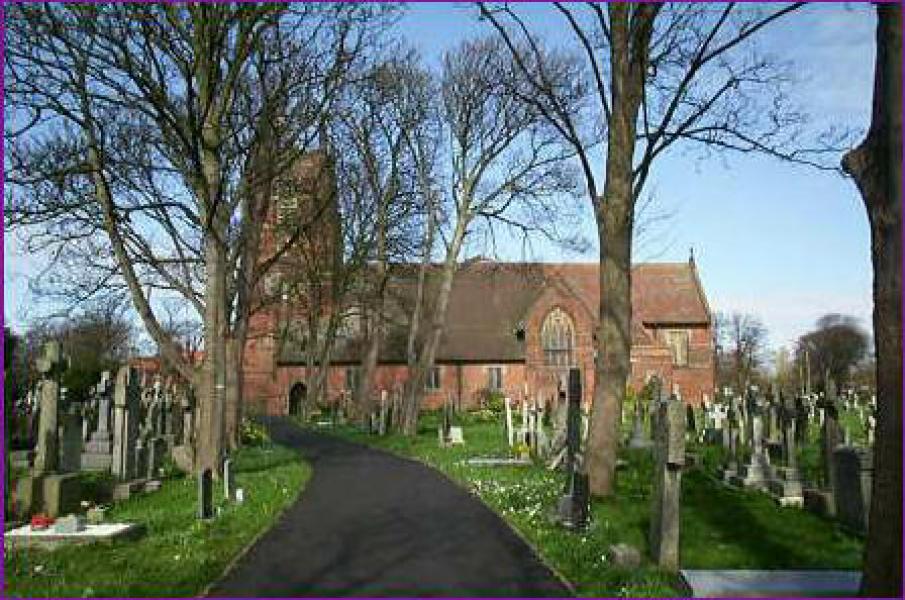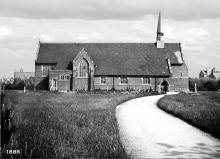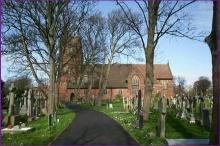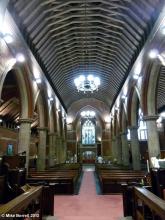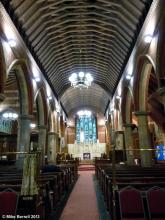In 1872 St.Anne's church was built in the area of the parish of Lytham then known as Heyhouses, but a new town, named after the church, has grown up around it. The road that it now stands on is St.Annes Road East. In 1924 it had a mission church on Orchard Road.
Church of St Anne
The Parish Church of St. Anne is the oldest church and building of substance in St. Annes. Prior to its existence divine service was held in the old Heyhouses School, but the accommodation was crowded and unsuitable. In 1871 the need for a new church was recognised, and Lady Eleanor Cecily Clifton offered to build one at her own expense.
In 1872 the Clifton Estate began laying the new road to the shore (now St Annes Road East/West) in readiness for the planned new town, and the site for the new church was carefully selected to meet the needs of both the expected new inhabitants and the Heyhouses farmers and fishermen. That same year Lady Cecily laid the foundation stone, and, although originally conceived as the James Fair Memorial Church in memory of James Fair, the Clifton estate agent, it was decided that the church should be dedicated to St. Anne. Lady Cecily may have chosen the name after her aunt, Lady Anne Bentinck (this is incorrect she was Anne Beckett), from whom she received a legacy about this time. Squire Clifton gave the land and provided the first endowment, and the total cost of the church was just over £4,000.
The church was consecrated in August 1873 and the following Saturday Lady Cecily invited local farmers, who had helped to cart building materials to the site, and other residents, to a dinner in Heyhouses School.
Architects Paley and Austin of Lancaster designed the church in mixed Gothic style. The structure is red brick in English bond with some pebble inlay, sandstone dressings and a red pantile roof. The main contractor was G. Smith of Great Marton.
The church originally seated 300 and had a spirelet to hold the bell. In 1886 R.K. Freeman enlarged it, and the square two-stage west tower was completed in 1890. The tower has stone bands to the first stage with diamond pattern pebble inlay, and a set-back belfry stage. In 1897 the tower clock was erected to commemorate Queen Victoria’s Diamond Jubilee, and soon afterwards the spirelet was removed. There have been some further additions to bring the church to its present form.
Work on the new town began in 1875 and the resort was named St Annes on the Sea after the church.
Lych gate and boundary wall to the churchyard of Church of St Anne
Although the church itself was completed in 1873, the lych gate could not be finished until late 1874 because of a design problem with the gable tiles. The lych gate was originally sited at the east gate entrance, and the first funeral to pass through it was that of fisherman’s son, George Melling, aged 2, in February 1875. A few years later the whole structure was moved to its present position when it became clear that as the new town developed more funerals would pass through the west gate.
The Tudor style lych gate has a carved open timber frame and red tiled roof. The wooden gates have quatrefoils in the top panels.
The boundary wall enclosing the triangular churchyard was built in time for the church’s consecration in 1873. The wall is of red brick, approximately 1 metre high, and has wide sunken panels filled with cobble stones, and a coping of three courses of chamfered brick. The churchyard itself contains an interesting collection of memorials and sculptures which chronicle the development of the town, some of which are included later.
from "The listed buildings of Lytham St. Annes" - Lytham St. Annes Civic Society 2003
If you have additional information or pictures that may usefully added to this page then please get in touch with us.
